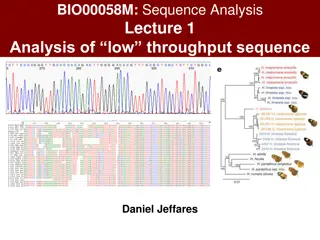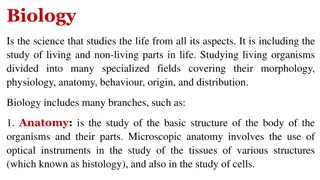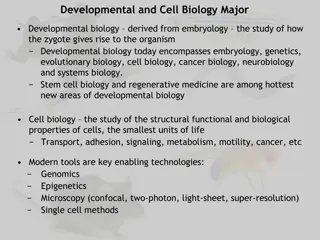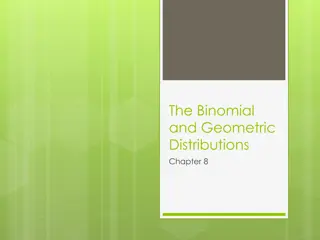Introduction to Binomial Nomenclature in Biology
Binomial nomenclature is the formal system of naming living organisms, providing each species with a unique two-part scientific name. This system ensures clarity and standardization in scientific communication. Understanding the rules and significance of binomial nomenclature is crucial in the field of biology.
Download Presentation

Please find below an Image/Link to download the presentation.
The content on the website is provided AS IS for your information and personal use only. It may not be sold, licensed, or shared on other websites without obtaining consent from the author. Download presentation by click this link. If you encounter any issues during the download, it is possible that the publisher has removed the file from their server.
E N D
Presentation Transcript
TISHK INTERNATIONAL UNIVERSITY Faculty of Education Biology Department 2019- 2020 Lab.3 Lab.3 Protozoa Protozoa ( (2 2nd nd Grade) Grade) By: Yad By: Yad Sirwan Sirwan yad.Sirwan@ishik.edu.iq
Objectives Objectives Define Binomial Nomenclature. Identify Protozoa with its common characteristics. Understand Ciliophoran.
Binomial nomenclature Binomial nomenclature Binomial nomenclature is the formal naming system for living things that all scientists use. It gives every species a two-part scientific name. For example, a ladybug goes by the fancy name of Harmonia axyridis. The first part of a scientific name, like Harmonia, is called the genus. A genus is typically the name for a small group of closely related organisms. The second part of a scientific name, axyridis in this example, is the specific epithet. It is used to identify a particular species as separate from others belonging to the same genus. Together, the genus plus the specific epithet is the full scientific name for an organism.
Binomial Binomial nomenclature rules nomenclature rules Because scientific names are unique species identifiers, they ensure that there is never any confusion as to which organism a scientist may be referring. Additionally, there are some important rules that must be followed to keep all binomial names standardized The entire two-part name must be written in italics (or underlined when handwritten). The genus name is always written first. The genus name must be capitalized. The specific epithet is never capitalized.
Phylum: Phylum: Protozoa Protozoa Kingdom Kingdom: : Protista Protista Subkingdom Subkingdom: : Protozoa Protozoa Phylum Phylum: : Protozoa Protozoa The word protozoa is come from Greek protozoon word meaning First Animal .
C Characteristics of Protozoa haracteristics of Protozoa Protozoa do not have a cell wall cell wall and therefore can have a variety of shapes Body is unicellular two regions; ectoplasm and endoplasm. The body is either bilaterally, radial symmetry or asymmetry. unicellular performs all functions of the body. The cytoplasm is divided into Protozoa prefer living in moist and aquatic habitats. Their cysts can be found in the bleakest parts of the ecosphere. There are both H Heterotrophic eterotrophic and Autotrophic Autotrophic based on their type of nutrition. Live Live freely freely, may be parasitic parasitic or symbiotic symbiotic. Respiration is by diffusion. Movement is by pseudopodia, flagella, cilia pseudopodia, flagella, cilia. . Reproduction occurs asexually and sexually. Excretion is via contractile vacuoles or by diffusion.
Locomotion in Protozoa Locomotion in Protozoa Protozoa are classified into Four main types based on their motility Flagellates Flagellates move by help of Flagella (a tail-like structure ). The movement is whip like Ciliates Ciliates protozoa have movement through cilia( fine hair like structure attached with their body). Sarcodina Major loco-motor organelles in Sarcodina is pseudopodia (Pseudo means false, podia means Foot) Sporozoates Sporozoates are the only non-motile form of protozoa.
Reproduction in Protozoa Reproduction in Protozoa Protozoa can reproduce their offspring by both Sexual and Asexual methods Asexual Asexual methods of reproduction are: Budding Binary Fission Schizogony or Multiple Fission Sexual Sexual Methods: Conjugation Gametogony
Respiration Respiration in Protozoa in Protozoa Based on the mode of respiration, protozoa are classified into Based on the mode of respiration, protozoa are classified into two two groups. groups. Aerobic Aerobic Protozoa: Protozoa: Most species of free-living protozoa are aerobic. They cannot live without oxygen. Aerobic protozoa are tiny and so are capable of getting oxygen from the liquid medium by diffusion. Example: Amoeba proteus. Anaerobic Anaerobic Protozoa They can survive in the absence of oxygen and are not commonly found amidst eukaryotic organisms. Normally, anaerobic eukaryotes are either parasites or symbionts of multicellular organisms that have originated from aerobic ancestors. Example: Giardia. Protozoa
Classification Classification Kingdom Kingdom Protista Protista Subkingdm Subkingdm Protozoa Protozoa phylum phylum protozoa protozoa subphylum subphylum Sarcomastigophora Sarcomastigophora Superclass: sarcodina Superclass: sarcodina _ _superclass Amoeba Amoeba sp. sp. Sporozoa Sporozoa C Ciliophora iliophora superclass: mastigophore : mastigophore Euglena Euglena sp. sp. Plasmodium Plasmodium sp. sp. genus genus Paramecium Parameciumsp Vorticella sp. Vorticella sp. sp. . 1.Entamoeba 1.Entamoeba histolytica histolytica Toxoplasma Toxoplasma sp. sp. Trypanosoma Trypanosoma sp sp. . Balantidiumcoli Balantidiumcoli. . 2.E.Coli 2.E.Coli
Question time!






























